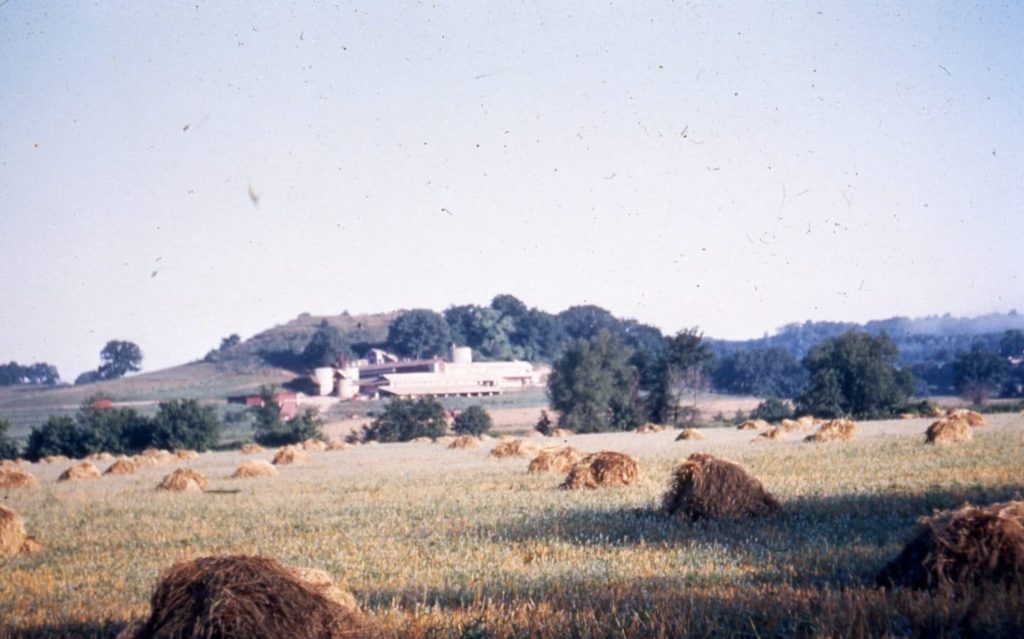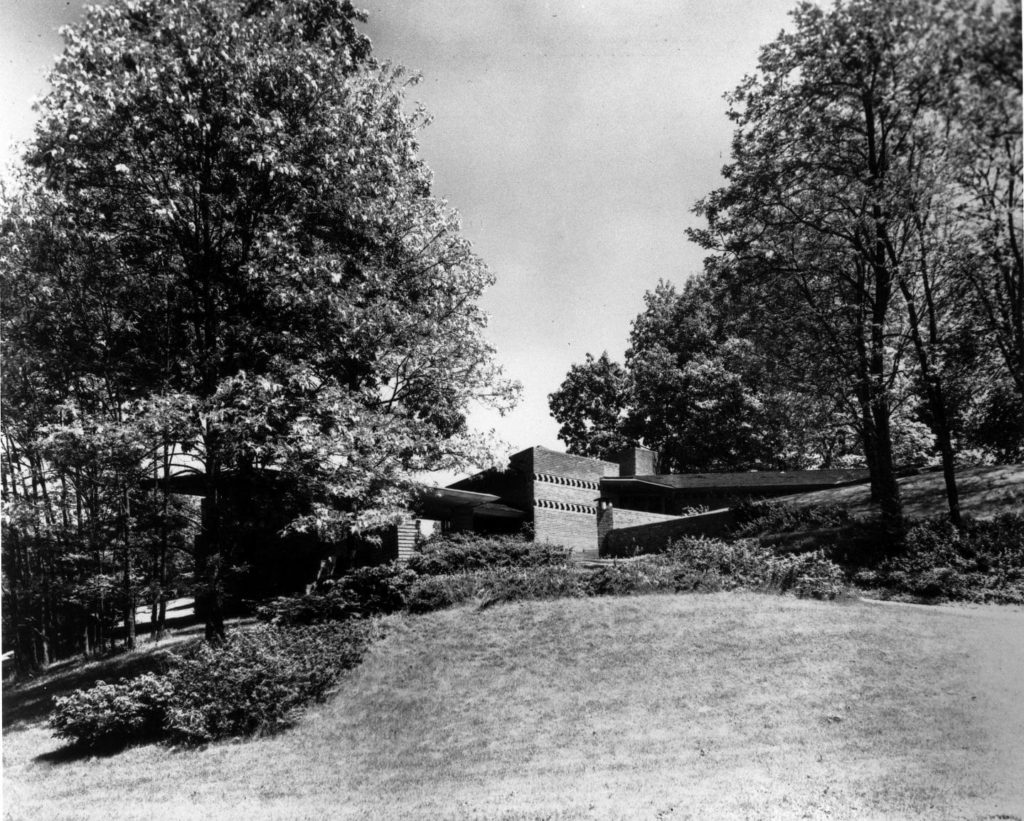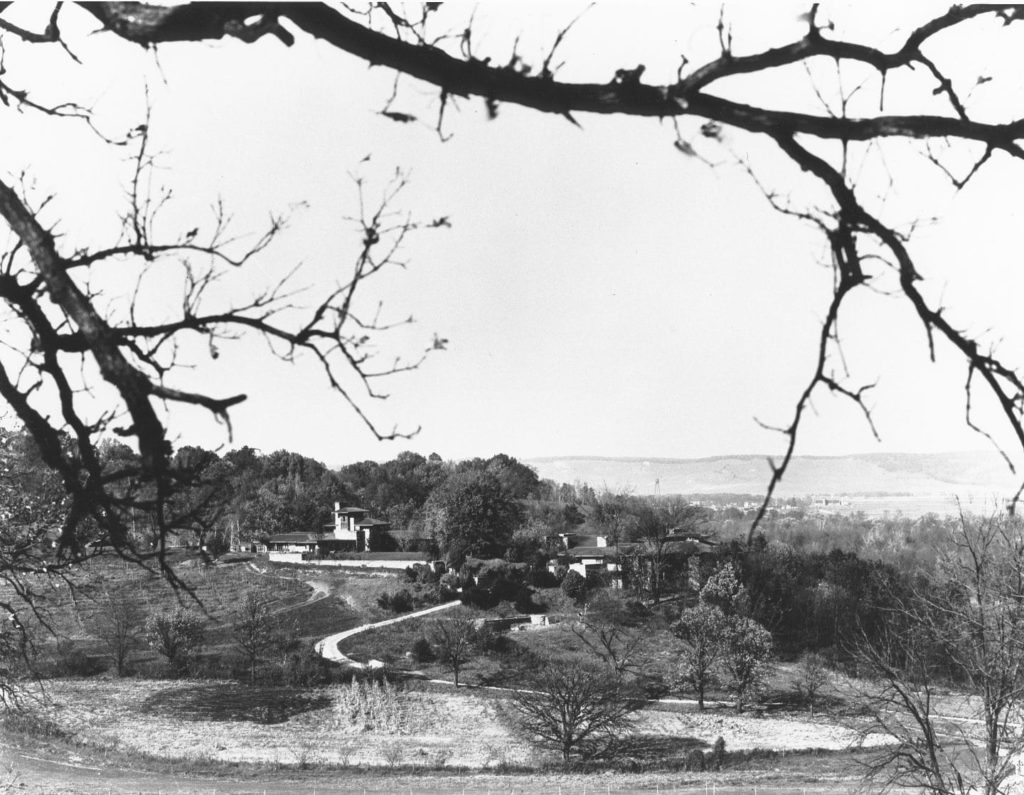

Organic Architecture and the Sustaining Ecosystem
By Stuart Graff
Perhaps the most elusive concept in all of Frank Lloyd Wright’s work is the notion of “organic architecture,” a thing that Wright struggled to define (and redefine) through his lifetime. For Wright, organic architecture was the essence of his creativity—the thing that made his work distinct, superior, and unquestionably American—and also a thing that responded to the challenges of modernity, technological advance, and social change.
Today, many views exist on the nature and qualities of organic architecture. For some, it is an architecture rooted in nature’s forms and principles; for others, the focus is on the connection from interior to exterior and the use of abstracted plant geometries. Some see it in the use of natural materials such as unadorned wood and stone, juxtaposed with modern materials like concrete. Others see it in Wright’s use of interpenetrating volumes and contrasts—light and dark, compressing and releasing—to take the occupant of a building on a journey as if through nature. All of these interpretations have a basis in Wright’s words, and of course in his works, and so organic architecture is at once all of these things.
Yet, there is an underlying idea, a theory of organic architecture, that knits these expressions of organicity together. In fact, there is much that we can learn about the underlying concept of organicity in Wright’s work through the contemporary lens of sustainability. Sustainability is, in fact, the clear import of Wright’s theory of organic architecture.
“The notion of organic not as a thing, but as the character of a thing, living and active as an intrinsic quality that emerges in varied forms responsive to the surrounding environment—became Wright’s essential principle.”

Sustainability and its Ecological Roots
Sustainability is a word that, like organic, is used sloppily, carelessly. Wright, however, would have enjoyed this word, because it captures the idea that he was trying to express through his career—a sustainable ecosystem comprising nature, the built environment, and human life, in which each component supports the other components and all thrive as a result.
“Ecosystem” is the critical term in this formulation; coined in 1935 from two Greek roots (oikos, meaning home, and systema, meaning “combined in a whole”) by British botanist Arthur Tansley to mean “a particular category of physical systems, consisting of organisms and inorganic components in a relatively stable equilibrium, open and of various sizes and kinds.” As the concept of ecosystems became generally accepted, it is not surprising that the term has been applied beyond the universe of interactions among plants, animals, and the surrounding environment, to refer to any complex network of interdependent systems.
Interdependence is central to every ecosystem, because within an ecosystem all components survive and thrive only because every component survives and thrives. The dominance of any single component usually spells the death of any ecosystem. It is for this reason that nature abhors monocultures—the dominance of a single species consuming all available resources to the detriments of any competitor.
Wright, as a keen observer of the natural world, found inspiration in the systems and processes that nature itself employed to create thriving ecosystems untouched by human intervention. Born in rural Wisconsin and spending his teenage years “adding tired to tired” on his uncle’s farm, Wright saw a vibrant natural world around him—in the form of domesticated crops, but also in the untouched woods and open spaces of the unglaciated Wisconsin River valley. It was here that his concept of “organic architecture” had its origins, and where Wright would spend much of his life’s work trying to define, elaborate, and practice it. Later, settling in the “green” Sonoran Desert of Arizona, Wright would encounter new ecosystems to challenge and inspire his work.

The Early Concept of Wright’s Organic Architecture
“A knowledge of the relations of form and function lies at the root” of the architect’s
work, Wright wrote In the Cause of Architecture (1908), and this he would formulate into six core propositions of organicity:
- Simplicity and repose are qualities that measure the true value of any work. From this, Wright saw the need to simplify the design of a structure, reducing the number of distinct rooms and rethinking them as open spaces, including even those to be contained within a single room. Windows and doors should be treated as part of the ornamentation of a structure, and even furnishings be made a part of the structural whole.
- In true democratic fashion, the style of a building should respond to the unique personality of the individual with which it is associated.
- A building should appear to grow easily from its site, and be shaped as if it was itself created by nature for and from that landscape.
- Color should derive from fields and woods to fit with these natural forms.
- The nature of the materials from which a building is constructed should be expressed freely.
- Buildings must be sincere, true, gracious, loving, and filled with integrity.
In these six principles one sees the advance from the earlier work of Wright’s mentor, Louis Sullivan (“form follows function”) to Wright’s own axiomatic observation that form and function are not merely linked, but rather are integral (“form and function are one”). These values informed the structure and operation of the Taliesin Fellowship over many decades; they would also inform his creation of an American architecture.
In Wright’s view, the core American value, the root of democracy, lay in a “gospel of individuality” that was intrinsic to human nature. This view emerged in writings, talks, and lectures that made frequent reference to Emerson, Thoreau, and Whitman—the holy trinity of Transcendental philosophy. Whitman in particular became a channel for Wright’s expression of the relationship of architecture, nature, and culture. At Taliesin West, Wright reflects this relationship through a quotation from Whitman’s Song of the Universal describing an America that is “embracing, carrying, welcoming all, Thou too, by pathways broad and new, To the Ideal tendest.”
It notable that this text is etched into a concrete at the entrance to Taliesin West, and is positioned so that the reader faces the desert landscape with a view over the valley toward the Phoenix Mountains—and one’s back is turned to the Taliesin West campus. To this text Wright appended stones bearing Hohokam petroglyphs, reflecting his reverence for ancient people whose only technology was nature and that which they could derive from nature. The Hohokam used this knowledge to survive in the hostile climate of the Sonoran Desert. In this synthesis of nature, the solutions for living that it offered, and the promise of idealized democracy, Wright established his manifesto of organic architecture that the visitor to Taliesin West would encounter, and understand, before coming into the spaces and buildings of Wright’s design.

A Definitive Statement: Organicity as Intrinsic and Integrated
Clearly frustrated by the misuse and misunderstanding of the ideas underlying organic architecture, Wright wrote in 1953 a Square Paper on the “Language of an Organic Architecture.” Starting with the observation that “organic (or intrinsic) architecture is the free architecture of ideal democracy,” he established a lexicon to explain his meaning (with the bold text emphasized in the original):
- NATURE: More than clouds, trees, terrain, and animal life, Wright intended for nature to refer to the nature of these things as well as the nature of materials, the nature of a plan, a sentiment, a tool “from within”—an “interior nature” or inherent principle around which every thing is composed or defined.
- ORGANIC: Wright looked at this term in a technical rather than vernacular sense, with reference to an entity or an integrated relationship among partners. “Organic means Part-to-Whole-as-Whole-is-to-Part. So Entity as integral is what is really meant by the word Organic.”
- FORM FOLLOWS FUNCTION: Elaborating on his numerous earlier pronouncements on this relationship, Wright observed that “Form is predicated on function but, so far as poetic imagination can go with it without destruction, transcends it. . . . Only when we say or write ‘Form and Function are One’ is the slogan significant.”
- ROMANCE: Wright hated the sentimentalization of romance and beauty, calling it reactionary. Instead, his romance referred to the creativity, the act of creation, and in particular the creation of “humane expressions of form” in contrast to inanimate facades. “Poetry of Form is as necessary to great architecture as foliage is to the tree, blossoms to the plant or flesh to the body.” He eschewed the “mechanization of building,” by which he seems to refer to the stripped bare work of Corbusier and other practitioners of the International Style, unless it serves creative architecture.
- TRADITION: This Wright relates to “Truth,” by which he refers to a principle of universal applicability. Wright compares the idea of Truth to a genus (bird), from which may flow many species (“flocks of infinitely differing birds of almost unimaginable variety”); he states that “flocks of traditions may proceed to fly from generic tradition into the unimaginable many,” but that they lack creative capacity because they are “only derivative.” “Truth is a divinity in architecture.”
- ORNAMENT: Wright believed that integral ornamentation was to architecture what efflorescence of a tree or plant is to its structure—“of the thing, not on it.” Ornament was emotional in its nature, emerging from “the character of structure revealed and enhanced.”
- SPIRIT: “Spirit grows upward from within and outward,” existing “within a thing itself as its very life.” The quality of spirituality in a building, Wright believed, could not be bestowed externally.
- THIRD DIMENSION: Here Wright distinguished a spiritual quality from physical existence, observing that the third dimension is not thickness but rather “a sense of depth which issues as of the thing not on it,” intrinsic to a structure. It is a depth of character in a sense, rather than a physical dimension.
- SPACE/STYLE: Perhaps the most elusive of Wright’s definitions, he refers to space not as a fixed quantity or volume, but rather as an action, a motivating force, “the continual becoming: invisible fountain from which all rhythms flow to which they must pass. Beyond time or infinity.” In Wright’s organic architecture, space is “the breath of a work of art.”
The notion of organic not as a thing, but as the character of a thing, living and active as an intrinsic quality that emerges in varied forms responsive to the surrounding environment—became Wright’s essential principle. As any living thing grows from within and adapts to its environment in that it may thrive, so Wright appears to have believed that buildings should grow from within and be adapted to their environment.
These expressions, however, were not complete without reference to the human purpose that they served. In the same Square Paper, Wright observed, “what is a building without intimate relationship to the ground it stands upon and the inhabitants who occupy it?” This relationship to human activity completed Wright’s thinking—that buildings, landscape, and lives should work together in such a way that all elements would not only survive, but thrive as a consequence of interaction.
This interpretation of organicity—a single, unitary, and unifying relationship among building, landscape, and human life—reveals that Wright wasn’t merely designing buildings based on the forms and principles of the natural world; rather, he was designing buildings to be a part of the world around them, so that our lives, interposed within that relationship, could thrive sympathetically with the built world and the embracing landscape.
The idea that human activity is central to the organic concept was celebrated in Wright’s drafting room at Taliesin. “What a man does, that he has,” he wrote in The Natural House and inscribed on the studio wall, to explain the unifying principles between form and function, nature and machine. Human activity gave meaning in Wright’s world, and the purpose of that activity was to serve both one’s self and one’s world. This he expressed in structures that were designed to reflect changing modes of living, including the elimination of household servants, the changing roles of women, the rise of a middle class, and the advent of the automobile. Wright’s work reflected these changes in social structure with changes to the design of buildings and communities.